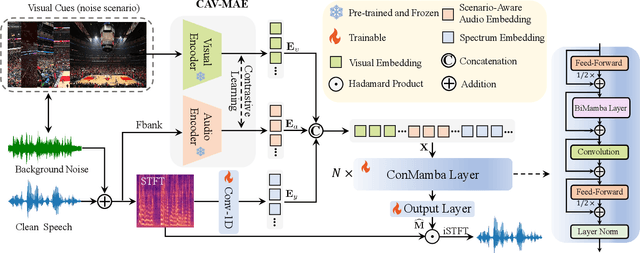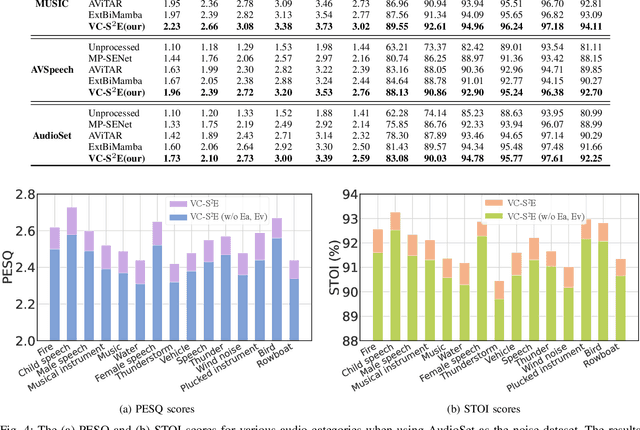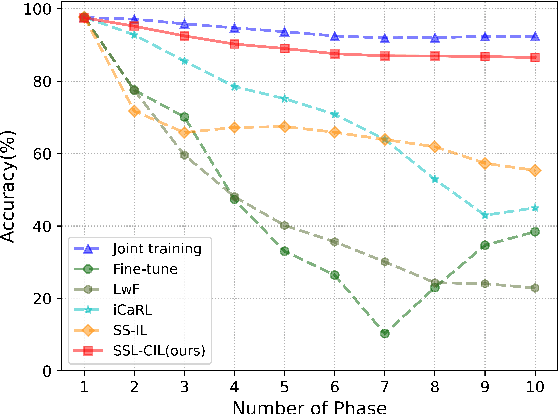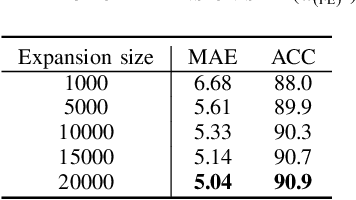Xinyuan Qian
Region-Specific Audio Tagging for Spatial Sound
Sep 11, 2025Abstract:Audio tagging aims to label sound events appearing in an audio recording. In this paper, we propose region-specific audio tagging, a new task which labels sound events in a given region for spatial audio recorded by a microphone array. The region can be specified as an angular space or a distance from the microphone. We first study the performance of different combinations of spectral, spatial, and position features. Then we extend state-of-the-art audio tagging systems such as pre-trained audio neural networks (PANNs) and audio spectrogram transformer (AST) to the proposed region-specific audio tagging task. Experimental results on both the simulated and the real datasets show the feasibility of the proposed task and the effectiveness of the proposed method. Further experiments show that incorporating the directional features is beneficial for omnidirectional tagging.
VP-SelDoA: Visual-prompted Selective DoA Estimation of Target Sound via Semantic-Spatial Matching
Jul 10, 2025Abstract:Audio-visual sound source localization (AV-SSL) identifies the position of a sound source by exploiting the complementary strengths of auditory and visual signals. However, existing AV-SSL methods encounter three major challenges: 1) inability to selectively isolate the target sound source in multi-source scenarios, 2) misalignment between semantic visual features and spatial acoustic features, and 3) overreliance on paired audio-visual data. To overcome these limitations, we introduce Cross-Instance Audio-Visual Localization (CI-AVL), a novel task that leverages images from different instances of the same sound event category to localize target sound sources, thereby reducing dependence on paired data while enhancing generalization capabilities. Our proposed VP-SelDoA tackles this challenging task through a semantic-level modality fusion and employs a Frequency-Temporal ConMamba architecture to generate target-selective masks for sound isolation. We further develop a Semantic-Spatial Matching mechanism that aligns the heterogeneous semantic and spatial features via integrated cross- and self-attention mechanisms. To facilitate the CI-AVL research, we construct a large-scale dataset named VGG-SSL, comprising 13,981 spatial audio clips across 296 sound event categories. Extensive experiments show that our proposed method outperforms state-of-the-art audio-visual localization methods, achieving a mean absolute error (MAE) of 12.04 and an accuracy (ACC) of 78.23%.
Exploring Length Generalization For Transformer-based Speech Enhancement
Jun 07, 2025Abstract:Transformer network architecture has proven effective in speech enhancement. However, as its core module, self-attention suffers from quadratic complexity, making it infeasible for training on long speech utterances. In practical scenarios, speech enhancement models are often required to perform on noisy speech at run-time that is substantially longer than the training utterances. It remains a challenge how a Transformer-based speech enhancement model can generalize to long speech utterances. In this paper, extensive empirical studies are conducted to explore the model's length generalization ability. In particular, we conduct speech enhancement experiments on four training objectives and evaluate with five metrics. Our studies establish that positional encoding is an effective instrument to dampen the effect of utterance length on speech enhancement. We first explore several existing positional encoding methods, and the results show that relative positional encoding methods exhibit a better length generalization property than absolute positional encoding methods. Additionally, we also explore a simpler and more effective positional encoding scheme, i.e. LearnLin, that uses only one trainable parameter for each attention head to scale the real relative position between time frames, which learns the different preferences on short- or long-term dependencies of these heads. The results demonstrate that our proposal exhibits excellent length generalization ability with comparable or superior performance than other state-of-the-art positional encoding strategies.
FIGhost: Fluorescent Ink-based Stealthy and Flexible Backdoor Attacks on Physical Traffic Sign Recognition
May 17, 2025Abstract:Traffic sign recognition (TSR) systems are crucial for autonomous driving but are vulnerable to backdoor attacks. Existing physical backdoor attacks either lack stealth, provide inflexible attack control, or ignore emerging Vision-Large-Language-Models (VLMs). In this paper, we introduce FIGhost, the first physical-world backdoor attack leveraging fluorescent ink as triggers. Fluorescent triggers are invisible under normal conditions and activated stealthily by ultraviolet light, providing superior stealthiness, flexibility, and untraceability. Inspired by real-world graffiti, we derive realistic trigger shapes and enhance their robustness via an interpolation-based fluorescence simulation algorithm. Furthermore, we develop an automated backdoor sample generation method to support three attack objectives. Extensive evaluations in the physical world demonstrate FIGhost's effectiveness against state-of-the-art detectors and VLMs, maintaining robustness under environmental variations and effectively evading existing defenses.
Audio-Visual Class-Incremental Learning for Fish Feeding intensity Assessment in Aquaculture
Apr 21, 2025



Abstract:Fish Feeding Intensity Assessment (FFIA) is crucial in industrial aquaculture management. Recent multi-modal approaches have shown promise in improving FFIA robustness and efficiency. However, these methods face significant challenges when adapting to new fish species or environments due to catastrophic forgetting and the lack of suitable datasets. To address these limitations, we first introduce AV-CIL-FFIA, a new dataset comprising 81,932 labelled audio-visual clips capturing feeding intensities across six different fish species in real aquaculture environments. Then, we pioneer audio-visual class incremental learning (CIL) for FFIA and demonstrate through benchmarking on AV-CIL-FFIA that it significantly outperforms single-modality methods. Existing CIL methods rely heavily on historical data. Exemplar-based approaches store raw samples, creating storage challenges, while exemplar-free methods avoid data storage but struggle to distinguish subtle feeding intensity variations across different fish species. To overcome these limitations, we introduce HAIL-FFIA, a novel audio-visual class-incremental learning framework that bridges this gap with a prototype-based approach that achieves exemplar-free efficiency while preserving essential knowledge through compact feature representations. Specifically, HAIL-FFIA employs hierarchical representation learning with a dual-path knowledge preservation mechanism that separates general intensity knowledge from fish-specific characteristics. Additionally, it features a dynamic modality balancing system that adaptively adjusts the importance of audio versus visual information based on feeding behaviour stages. Experimental results show that HAIL-FFIA is superior to SOTA methods on AV-CIL-FFIA, achieving higher accuracy with lower storage needs while effectively mitigating catastrophic forgetting in incremental fish species learning.
FaceSpeak: Expressive and High-Quality Speech Synthesis from Human Portraits of Different Styles
Jan 02, 2025



Abstract:Humans can perceive speakers' characteristics (e.g., identity, gender, personality and emotion) by their appearance, which are generally aligned to their voice style. Recently, vision-driven Text-to-speech (TTS) scholars grounded their investigations on real-person faces, thereby restricting effective speech synthesis from applying to vast potential usage scenarios with diverse characters and image styles. To solve this issue, we introduce a novel FaceSpeak approach. It extracts salient identity characteristics and emotional representations from a wide variety of image styles. Meanwhile, it mitigates the extraneous information (e.g., background, clothing, and hair color, etc.), resulting in synthesized speech closely aligned with a character's persona. Furthermore, to overcome the scarcity of multi-modal TTS data, we have devised an innovative dataset, namely Expressive Multi-Modal TTS, which is diligently curated and annotated to facilitate research in this domain. The experimental results demonstrate our proposed FaceSpeak can generate portrait-aligned voice with satisfactory naturalness and quality.
Breaking Through the Spike: Spike Window Decoding for Accelerated and Precise Automatic Speech Recognition
Jan 01, 2025



Abstract:Recently, end-to-end automatic speech recognition has become the mainstream approach in both industry and academia. To optimize system performance in specific scenarios, the Weighted Finite-State Transducer (WFST) is extensively used to integrate acoustic and language models, leveraging its capacity to implicitly fuse language models within static graphs, thereby ensuring robust recognition while also facilitating rapid error correction. However, WFST necessitates a frame-by-frame search of CTC posterior probabilities through autoregression, which significantly hampers inference speed. In this work, we thoroughly investigate the spike property of CTC outputs and further propose the conjecture that adjacent frames to non-blank spikes carry semantic information beneficial to the model. Building on this, we propose the Spike Window Decoding algorithm, which greatly improves the inference speed by making the number of frames decoded in WFST linearly related to the number of spiking frames in the CTC output, while guaranteeing the recognition performance. Our method achieves SOTA recognition accuracy with significantly accelerates decoding speed, proven across both AISHELL-1 and large-scale In-House datasets, establishing a pioneering approach for integrating CTC output with WFST.
I2TTS: Image-indicated Immersive Text-to-speech Synthesis with Spatial Perception
Nov 20, 2024Abstract:Controlling the style and characteristics of speech synthesis is crucial for adapting the output to specific contexts and user requirements. Previous Text-to-speech (TTS) works have focused primarily on the technical aspects of producing natural-sounding speech, such as intonation, rhythm, and clarity. However, they overlook the fact that there is a growing emphasis on spatial perception of synthesized speech, which may provide immersive experience in gaming and virtual reality. To solve this issue, in this paper, we present a novel multi-modal TTS approach, namely Image-indicated Immersive Text-to-speech Synthesis (I2TTS). Specifically, we introduce a scene prompt encoder that integrates visual scene prompts directly into the synthesis pipeline to control the speech generation process. Additionally, we propose a reverberation classification and refinement technique that adjusts the synthesized mel-spectrogram to enhance the immersive experience, ensuring that the involved reverberation condition matches the scene accurately. Experimental results demonstrate that our model achieves high-quality scene and spatial matching without compromising speech naturalness, marking a significant advancement in the field of context-aware speech synthesis. Project demo page: https://spatialTTS.github.io/ Index Terms-Speech synthesis, scene prompt, spatial perception
SAV-SE: Scene-aware Audio-Visual Speech Enhancement with Selective State Space Model
Nov 12, 2024



Abstract:Speech enhancement plays an essential role in various applications, and the integration of visual information has been demonstrated to bring substantial advantages. However, the majority of current research concentrates on the examination of facial and lip movements, which can be compromised or entirely inaccessible in scenarios where occlusions occur or when the camera view is distant. Whereas contextual visual cues from the surrounding environment have been overlooked: for example, when we see a dog bark, our brain has the innate ability to discern and filter out the barking noise. To this end, in this paper, we introduce a novel task, i.e. SAV-SE. To our best knowledge, this is the first proposal to use rich contextual information from synchronized video as auxiliary cues to indicate the type of noise, which eventually improves the speech enhancement performance. Specifically, we propose the VC-S$^2$E method, which incorporates the Conformer and Mamba modules for their complementary strengths. Extensive experiments are conducted on public MUSIC, AVSpeech and AudioSet datasets, where the results demonstrate the superiority of VC-S$^2$E over other competitive methods. We will make the source code publicly available. Project demo page: https://AVSEPage.github.io/
Analytic Class Incremental Learning for Sound Source Localization with Privacy Protection
Sep 11, 2024



Abstract:Sound Source Localization (SSL) enabling technology for applications such as surveillance and robotics. While traditional Signal Processing (SP)-based SSL methods provide analytic solutions under specific signal and noise assumptions, recent Deep Learning (DL)-based methods have significantly outperformed them. However, their success depends on extensive training data and substantial computational resources. Moreover, they often rely on large-scale annotated spatial data and may struggle when adapting to evolving sound classes. To mitigate these challenges, we propose a novel Class Incremental Learning (CIL) approach, termed SSL-CIL, which avoids serious accuracy degradation due to catastrophic forgetting by incrementally updating the DL-based SSL model through a closed-form analytic solution. In particular, data privacy is ensured since the learning process does not revisit any historical data (exemplar-free), which is more suitable for smart home scenarios. Empirical results in the public SSLR dataset demonstrate the superior performance of our proposal, achieving a localization accuracy of 90.9%, surpassing other competitive methods.
 Add to Chrome
Add to Chrome Add to Firefox
Add to Firefox Add to Edge
Add to Edge